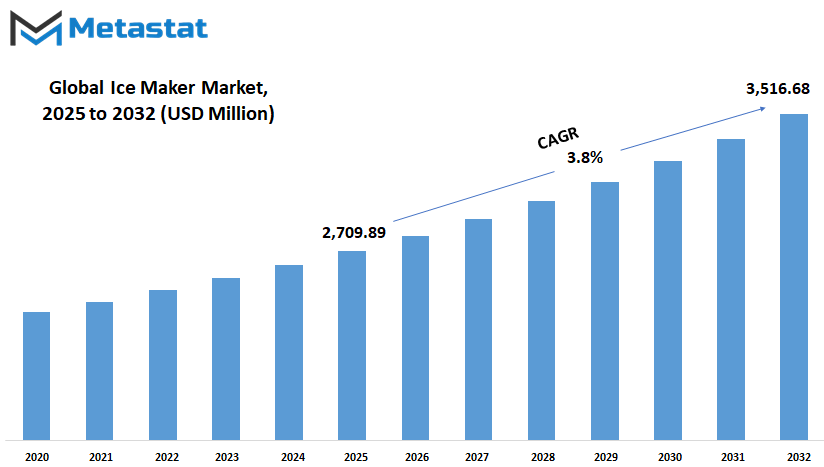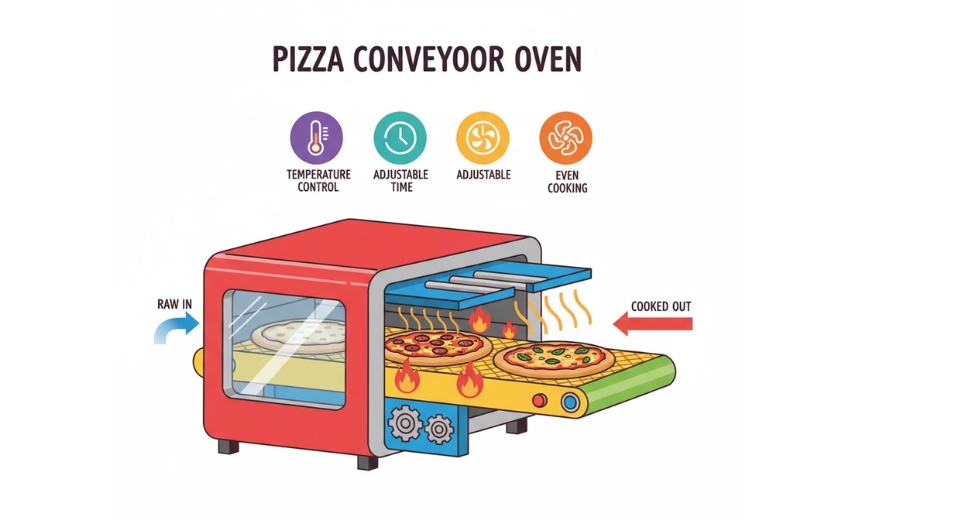MARKET OVERVIEW
The global ice maker market has a significant role to play in the refrigeration industry serving numerous different industries that need the generation of ice for some given purpose such as in food service, healthcare and other industrial applications. Ice makers are specialized equipment meant to generate ice in various forms like cube, flake, and nugget. With increased need in residential as well as business areas, the industry will go on to develop with new technological changes aiming greater efficiency, consumption of energy, and output quality. The Global Ice Maker industry is served by varied industries, mainly food serving institutions such as restaurants, hotels, and bars, where ice is needed in order to store food, chill beverages, as well as satisfy consumers. Besides food and drink uses, the medical industry also plays a large part in the demand for ice-making machines within the market.
Ice machines are utilized by clinics and hospitals for medical treatment, e.g., bringing down body temperatures during surgery or chilling perishable medical devices. These diverse demands by different industries confirm the practicality of ice makers in contemporary society, and also their status as a vital machine in the daily operations of most industries. The future of Global Ice Maker will largely be driven by technology and consumer demand. Since companies are becoming more concerned with sustainability, there will be increasing focus on energy-saving and eco-friendly ice makers. More efficient and less power-consuming machines, which waste less water and have a lower environmental impact refrigerant will be made available by manufacturers. These will assist companies in adhering to tougher environmental laws and lowering their carbon footprint, making them attractive to green-conscious consumers.
In addition, the technological advancements in ice-making devices will make them faster and more efficient and will enable them to meet the increased demand for ice without sacrificing quality. Home market also has an important role in determining the fate of the market. As people's demand for home appliances rises for convenience, more and more people will begin to use ice makers for individual convenience. Homeowners will seek out small, convenient, and power-efficient models to install in the kitchen. Growing popularity of homemade ice production will propel another shift in the market as companies will try to develop models that are specific to small spaces and individualistic requirements. In addition, growing convenience store, fuel station, and supermarket popularity will help expand the global ice maker market. They need constant supply of ice for preservation of perishables, serving as beverages, and for meeting convenience needs of hectic consumers.
As retail chains expand, particularly in the emerging economies, there would be greater demand for commercial ice-making machines, which can produce high volumes of ice within a relatively short duration. Along with the constantly fluctuating Global Ice Maker industry, customer service, ease of maintenance, and robustness will be major concerns. More intelligent equipment with remote maintenance alert and monitoring systems will be available. These features will bring about enhanced customer satisfaction, greater machine longevity, and lesser down times. The Global Ice Maker industry will grow as enterprises and consumers demand better, greener, and functionally diversified ice machines. Technological breakthroughs and expanding needs from every sphere will decide the fate of this market. As a domestic or business necessity, ice makers will be a necessary product, fulfilling the increasingly burgeoning demand for ice for daily living and specialized industries.
Global ice maker market is estimated to reach $3,516.68 Million by 2032; growing at a CAGR of 3.8% from 2025 to 2032.

GROWTH FACTORS
The global ice maker market is poised to experience consistent growth in the years to come as a result of evolving lifestyles among consumers and increasing demand from various industries. With changing preferences among people and the food and beverage industry constantly growing, the demand for trustworthy ice-making machines will continue to increase. Restaurants, hotels, hospitals, and convenience stores are among some of the organizations for which ice is not only a luxury but also a necessity. This consistent demand is among the major drivers of the growth of the global ice maker market. The trend towards quick service and ready-to-serve establishments will also support this growth.
Customers seek faster service and improved-quality experience, which compels companies to spend on efficient ice makers. Also, growth in supermarkets and cold storage facilities will contribute to increased demand for ice machines. Advancements in technology in ice maker designs, particularly energy-efficient types, will drive more consumers to purchase. The demand for clean, safe ice in the healthcare and pharmaceutical industries further reinforces demand. A further major driving factor is the movement towards sustainable business practices. Lower water and electric consumption ice makers are becoming more popular.
Industry players are busy developing environmentally friendly models that will satisfy commercial requirements as well as environmental demands. With increasing temperatures around the globe, cold storage and drinks require become even greater, further necessitating high-quality ice makers. Also, the tourism sector will further boost this growth, as hotels and entertainment venues continue to open and grow globally. But some challenges may hinder the growth.
The cost of sophisticated machinery and maintenance may be high enough to deter small and medium-sized enterprises from adopting them. Electricity supply or water shortages in some areas may also be a hindrance to market growth. All these may create apprehension in potential customers, particularly in emerging regions. In spite of these issues, improvements in automation and intelligent features in ice makers would offer profitable opportunities for the market in future years. Remote control of machines, tracking consumption, and minimizing energy expenditure attract contemporary consumers.
Configurable designs that accommodate various business models and space dimensions also render future adoption more versatile. The global ice maker market is likely to continue progressing, fueled by innovation and the increasing demand for effective cooling solutions in various industries.
MARKET SEGMENTATION
By Type
The global ice maker market will experience significant change in the future as it is influenced by changing consumer requirements and increasing demand from various industries. With modernization of lifestyle, ice makers are no longer considered a luxury but a necessary appliance in the foodservice industry, hospitals, hotels, and homes. As expectations rise with people, there will be increased pressure on machines to be efficient, space-saving, and to generate clean ice every time.
By their type, the market will remain influenced by how well various machines perform and are flexible in terms of usage. Modular ice makers find application in the busy commercial environment. They are designed to make a vast amount of ice and function in conjunction with independent storage units, a feature that is suitable for areas that require a significant amount on a daily basis. Undercounter ice makers, which is their name, are created to fit comfortably under the counter. They are common in cafes and restaurants where space is limited but constant ice production is required.
Their small size, coupled with moderate output, makes them a convenient option. Countertop ice makers, however, will receive more popularity because of how easy they are to use and how portable they are. Many businesses and even homes prefer these because they can make ice in a short while without requiring much space. The "others" group will most probably contain specialty models and innovative designs that have reduced water and energy use or special shapes and functions suited for particular applications.
What is certain is that technology will remain central to determining how these machines function. The global ice maker market will react to sustainability and energy concerns. Manufacturers will probably create machines that are not only quicker but also quieter and more sustainable. Smart controls and app connectivity could become standard, enabling users to track performance and make changes remotely. With increasing demand in various environments, there will be a higher emphasis on speed, hygiene, and compact design.
This will drive innovation in new models that will meet evolving expectations. Be it for a city's coffee shop or a medical centre requiring robust cooling, the market will continue expanding and evolving. The Global Ice Maker industry will not only be about producing ice it will be about fulfilling needs smarter and more efficiently.
By Product Type
For instance, upcoming models can utilize sensors to regulate ice production according to usage patterns. This saves energy and minimizes waste. Such machines can also have remote monitoring, allowing users to control them from their phones or computers. This will be particularly useful in large establishments where multiple units need to be controlled. With more awareness of the use of energy and its consequences, less-power-consuming and less-water-consuming ice makers will find favor. In terms of product type, the market is categorized into Cube Ice, Nugget Ice, Gourmet Ice, Crescent Ice, and others. Each of them has a different use.
Most prevalent is the Cube Ice and it is also used in beverages. Its slow-melt characteristic makes it best suited to chill drinks for a longer duration. Nugget Ice is easier to chew and softer, thus favored in the healthcare sector as well as in some restaurants. Gourmet Ice is unique due to its clear and sophisticated appearance, and most often it is used in upmarket bars and restaurants. Crescent Ice is designed to conserve space and enhance the flow of liquid in a glass, whereas other varieties remain to play specialized roles that are dependent on their environment.
As consumer expectations move towards higher quality and effectiveness, companies will aim to design ice makers that meet these expectations. Whether faster production, improved taste, or ease of maintenance, the future of the global ice maker market will hold increasingly user-friendly and eco-friendly machines. Increased tourism, city dwelling, and healthcare will drive this further. Given these trends, companies will invest in durable ice-making machines that are able to cope with both present and emerging demands without sacrificing performance.
By Application
The global ice maker market will have consistent growth since commercial and household needs will still evolve. Future ice makers won't be just about making ice efficiently. They'll also be required to abide by new measures of energy efficiency, intelligence, and environmental safety. In restaurants, hospitals, hotels, and supermarkets, the need will continue increasing as a result of the requirement for clean, quick, and uniform ice-making. Companies will likely spend money on equipment that can make different forms of ice for diverse purposes—such as flake ice for use in displays of food or clear ice for use in drinks. While customers demand more personalized experiences, particularly in the hospitality sector, consistent ice manufacturing is part of the experience. For the residential market, a greater number of homes are likely to utilize freestanding or built-in ice makers.
Individuals are increasingly fascinated with convenience, and having fresh ice in the home without depending on customary freezer trays will be considered a small but precious luxury. This shift in behavior will probably encourage manufacturers to make quieter, more compact, and fashionable machines that are easily installable in contemporary kitchens. Ice makers with app control or voice command features might even be preferred by some households. These features will enhance the convenience of controlling ice production and checking the status of the machine. In the future, smart home integration will have a greater influence on how residential ice makers are designed. As increasingly more appliances become integrated into connected systems, ice makers will not be left behind. For instance, homeowners can get notifications when the machine needs to be cleaned or when ice levels are low.
Such innovation will enhance value and user experience. In the meantime, ecological issues will define the future of this market as well. Energy consumption and use regulations for some refrigerants will push brands to create more environmentally friendly models. Brands that will be able to balance performance and sustainability will dominate both commercial and residential markets. These devices will also be less wasteful to maintain, contributing to waste reduction in the long run.
The global ice maker market, both from a commercial and residential perspective, will continue to evolve as human needs and tastes change. Growth will be driven not just by how well they function but by how innovative, fashionable, and responsible they are. It will no longer suffice for ice makers to merely function efficiently—they will also have to integrate into an intelligent, more considered lifestyle and business model.
By Distribution Channel
The global ice maker market will see gradual changes in the way products are accessed and sold, particularly when viewed from the perspective of distribution channels. Historically, the majority of customers have gone to offline channels—this encompasses physical appliance stores, commercial equipment suppliers, and local dealers. These locations provide the advantage of hands-on demonstrations, one-on-one service, and the opportunity to see the machine firsthand before buying. For companies such as restaurants, hotels, and medical facilities, the opportunity to personally inspect and compare ice makers in-store remains an integral part of the purchasing process. Local sales agents and service personnel's confidence also reinforces the ongoing presence of offline sales. Yet the environment begins to shift more obviously.
With the spread of internet connectivity and growing familiarity with online transactions, the online channel is increasingly becoming an equally significant sales avenue. Browsing at convenience through a variety of choices at any given hour of the day, reading reviews from customers, and having home delivery have opened doors for the online channels. It is attracting individuals and enterprises alike to think about buying equipment like ice makers via websites. Advances in digital interfaces, secure payment channels, and enhanced product visualization on the internet will further drive this movement. The global ice maker market can expect increased investment in direct-to-consumer sites controlled by the manufacturer in the immediate future. It may help them retain more control over price and branding and foster deeper relationships with customers.
Online shopping sites will also increase, with wider product lines, aggressive prices, and add-on services such as installation and extended warranties. Meanwhile, the offline path will not disappear but may concentrate on providing expert advice, maintenance, and after-sales service in order to stay competitive. What this indicates is not an absolute transition from one channel of buying to another but a convergence of experiences. Some customers might shop online and then go to a store, while others might do the reverse. Such a blend will determine how ice makers are sold and marketed.
With technology revolutionizing the manner in which people make purchases, both offline and online platforms will keep evolving to meet customers' expectations. The global ice maker market won't only increase in terms of size but also in terms of response to how people prefer buying.
|
Forecast Period |
2025-2032 |
|
Market Size in 2025 |
$2,709.89 million |
|
Market Size by 2032 |
$3,516.68 Million |
|
Growth Rate from 2025 to 2032 |
3.8% |
|
Base Year |
2024 |
|
Regions Covered |
North America, Europe, Asia-Pacific, South America, Middle East & Africa |
REGIONAL ANALYSIS
The global ice maker market will keep expanding steadily in various regions of the world, influenced by local needs, lifestyle trends, and technological advancements. Observing how this market acts in various regions provides a clear image of what is to come. In North America, convenience and energy-saving appliances are the emphasis. Residents in nations such as the U.S. and Canada prefer machines that are efficient, simple to use, and utilize less power. With home bars, outdoor events, and fast-food restaurants gaining popularity, there will be strong demand for smaller and dependable ice makers. In Europe, the trend is somewhat different.
Though other countries like Germany, the UK, France, and Italy also cherish innovation, these are more sustainable and governed by high environmental regulations. Ice machines in these regions need to become environmentally friendly by employing refrigerants and materials that are less destructive to the environment. This may also lead producers to concentrate on producing machines with low water and power consumption without reducing performance. In the long run, this may influence new standards for products throughout the entire global ice maker market. Asia-Pacific is a region with the fastest growth because of increasing cities and a growing middle class. China, India, South Korea, and Japan are experiencing changes in the way people live and work, which drives demand for new kitchen and hospitality equipment.
Here, large food service organizations and homes are embracing ice makers to keep up with their evolving lifestyles. Increased tourism and food delivery will further drive demand for energy-efficient and smart machines. These markets are expected to witness increased local manufacturing in the near future, which can cut costs and meet growing demand. South America and Middle East & Africa offer unique challenges and opportunities. In South America, countries like Brazil and Argentina are increasingly interested, although economic changes can affect the rate of adoption. In the Middle East & Africa, regions like the Gulf nations and South Africa have high temperatures throughout the year, so ice is a daily requirement.
Demand here could grow as businesses like hotels and fast-food chains continue to expand. In the future, enhancing access to electricity and investment in cold chain infrastructure may ensure increased utilization of ice makers in these areas, defining a more resilient and robust global ice maker market.

COMPETITIVE PLAYERS
The global ice maker market will keep growing steadily in various regions of the world, influenced by regional demands, changes in lifestyle, and technological progress. Observing how this market operates in various regions provides a clear image of what is to come. In North America, convenience and energy-saving appliances are the priority. Individuals in nations such as the U.S. and Canada prefer machines that are efficient, easy to operate, and use less power. With the increasing popularity of outdoor events, home bars, and fast-food restaurants, demand for small and dependable ice makers will continue to be strong. Europe has a slightly different trend.
Though nations like Germany, the UK, France, and Italy do appreciate innovation, they are Sustainability and stringent environmental regulations push these nations. Ice makers in these countries are likely to become more environmentally friendly with the use of refrigerants and materials that minimize damage to the environment. This change is likely to also push manufacturers towards making machines that consume less water and electricity without sacrificing performance. With time, this may become the trend for future product standards in the whole global ice maker market. Asia-Pacific is a region that is often growing very fast with the expanding cities and a growing middle class. China, India, South Korea, and Japan are experiencing transformations in living and working, which drives demand for contemporary kitchen and hospitality equipment.
Both large-scale food establishments and homes in this region are converting to ice makers to suit their evolving lifestyles. Tourism and food delivery growth will continue to drive demand for efficient and smart machines. The future for these markets will involve more localized manufacturing, which can lower costs and accommodate increasing demand. South America and Middle East & Africa offer distinct challenges and opportunities. In South America, Brazil and Argentina are developing interest, though the economic dynamics can alter the pace of uptake. In the Middle East & Africa region, locations like the Gulf states and South Africa have extremely high temperatures throughout the year, with ice a need that needs to be satisfied daily.
Here demand is likely to rise as entities like fast food restaurants and hotels keep spreading their business. In the future, enhancing access to electricity and investing in cold chain infrastructure may be able to increase the utilization of ice makers in these markets, creating a more robust and stable global ice maker market.
Ice Maker Market Key Segments:
By Type
- Modular Ice Makers
- Undercounter Ice Makers
- Countertop Ice Makers
- Others
By Product Type
- Cube Ice
- Nugget Ice
- Gourmet Ice
- Crescent Ice
- Others
By Application
- Commercial
- Residential
By Distribution Channel
- Offline
- Online
Key Global Ice Maker Industry Players
- Manitowoc Ice
- Hoshizaki Corporation
- Scotsman Ice Systems
- Follett Corporation
- Cornelius Inc.
- Vogt Ice LLC
- Ice-O-Matic
- Brema Ice Makers
- Icematic
- ITV Ice Makers, Inc.
- Polar Ice
- Maxx Ice
- North Star Ice Equipment Corporation
- Kold-Draft
- Howe Corporation
- AV Refrigeration
- AB Electrolux
- Direct Catering Products Ltd
- U-Line Corporation
- Summit Appliance Division
- Marvel Refrigeration
- Whynter LLC
- Whirlpool Corporation
- GE Appliances
WHAT REPORT PROVIDES
- Full in-depth analysis of the parent Industry
- Important changes in market and its dynamics
- Segmentation details of the market
- Former, on-going, and projected market analysis in terms of volume and value
- Assessment of niche industry developments
- Market share analysis
- Key strategies of major players
- Emerging segments and regional growth potential








 US: +1 3023308252
US: +1 3023308252






